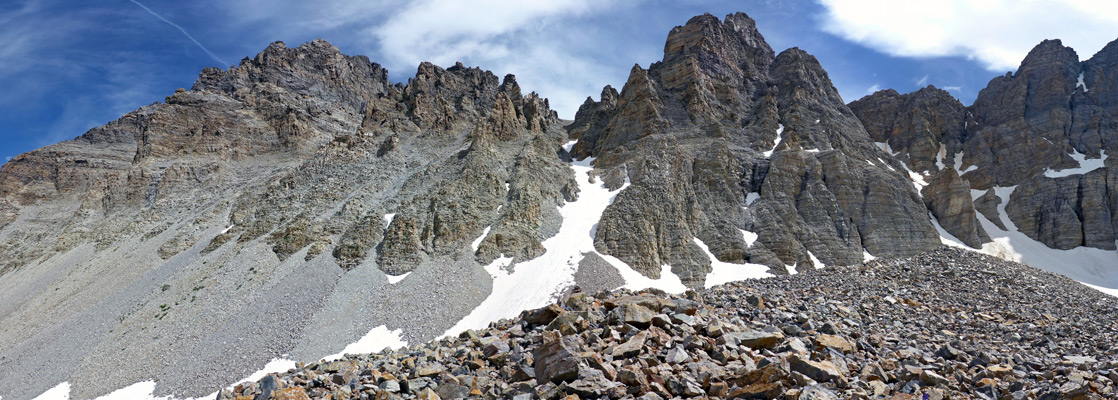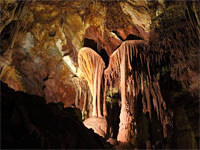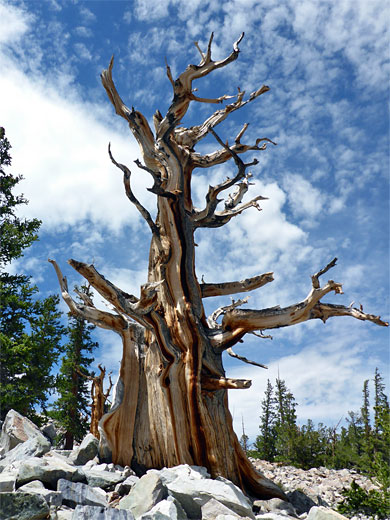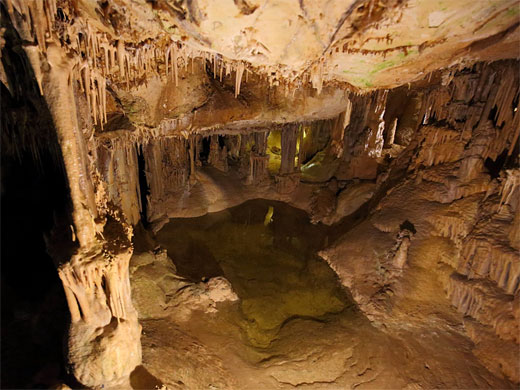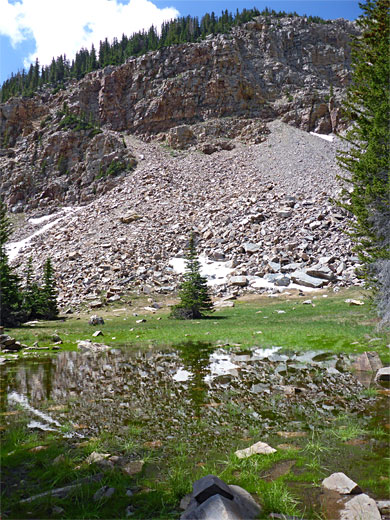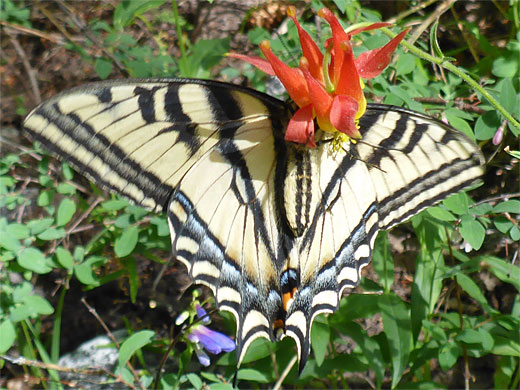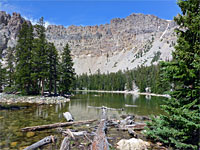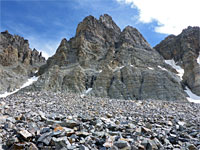Highlights:
Isolated mountain wilderness featuring varied climate zones, limestone caverns, a glacier, and far reaching views over the surrounding Great Basin Desert. Most visitors just drive the paved, 12 mile scenic road but there are many hiking trails and unpaved roads into the backcountry
Nearby town:
Ely, 66 miles
Management:
Location:
Seasons:
Spring, summer, fall
Rating (1-5):
★★★★★
Weather:
Great Basin NP is part of the Great Basin Desert itinerary
Limestone cavern filled with intricate formations, viewable on ranger-led tours, lasting either 60 or 90 minutes
Twelve mile drive that climbs to nearly 10,000 feet, giving access to several trailheads and scenic overlooks. Ends at Wheeler Peak campground
For the millions of people whose only experience of Nevada is a visit to the neon casinos of Las Vegas, where sunny skies and temperatures over 90°F are the norm, it may be a surprise to learn that just 250 miles north lie permanent snowfields and even a small glacier - these are found on 13,065 foot Wheeler Peak, the central attraction of the Great Basin National Park, which contains nearly 80,000 acres of high elevation terrain in the Snake Range, in the far east of the state near the Utah border.
Varied wildlife zones and great views over distant mountain and desert scenery make this a pleasant change from the featureless grey-green, sagebrush-covered plains that stretch over much of the state, and the park has one more unusual attraction in the Lehman Caves, a cavern system containing many beautiful limestone formations. The caves are visited on guided tours, for which tickets need to be purchased, preferably in advance, but the park as a whole is free to enter.
Varied wildlife zones and great views over distant mountain and desert scenery make this a pleasant change from the featureless grey-green, sagebrush-covered plains that stretch over much of the state, and the park has one more unusual attraction in the Lehman Caves, a cavern system containing many beautiful limestone formations. The caves are visited on guided tours, for which tickets need to be purchased, preferably in advance, but the park as a whole is free to enter.
Great Basin Table of Contents
- National park map
- Photographs
- The national park
- Approach to Great Basin NP
- Great Basin climate zones
- Camping in the national park
- Hiking in Great Basin National Park
- Wildflowers found in the national park
- Nearby places
- Similar places
Location
Map of Great Basin National Park.
Photographs
General views, Bristlecone/Glacier trails.
The National Park
Great Basin is probably the least known national park in the Southwest, partly as it was created quite recently, in 1986, prior to which only the caverns were officially recognized, as Lehman Caves National Monument, and partly as the area is far from any other famous landmark, and not reached by any major cross-country highway. It also has a rather limited opening season, since the one road into the high country is closed by snow between November and May, though the caves, and the lower reaches of the park, are open all year. As with some other mountains, such as the San Jacinto range near Palm Springs and the Guadalupe Mountains of Texas, as well as other hills in the Basin and Range landscape of Nevada, Wheeler Peak rises like an great island from the surrounding desert; at higher elevations, moisture increases and the temperature falls, resulting in several different plant and wildlife zones, over a vertical distance of 7,000 feet. The Snake Range is part of Nevada's Great Basin Desert, a vast area, dry for most of the year, characterized by long, wide valleys interspersed by narrow mountain ridges running generally north-south.
Approach to Great Basin NP
Great Basin National Park is close to US 50, supposedly 'The Loneliest Road in America', and the only trans-Nevada route that crosses into Utah for 210 miles, between I-80 in the north and NV 319/UT 56 to the south. Just 7 miles from the state border, another lonely road (NV 487) branches off; the park entrance is along a side road near the little town of Baker, after which NV 487 continues into Utah, becomes UT 21 and traverses wide-open, empty lands for 120 miles before eventually joining I-15. On the west side of the Snake Range, one of the many mountainous ridges that restrict east-west travel in Nevada, is US 93, another scenic highway that provides an alternative approach to the area, and the route to be used if starting from Las Vegas. The side road crosses open land at the edge of the Snake Valley, past an exhibit about the ranching history of the area, then enters the park and ends at the Lehman Caves visitor center. The main park visitor center is along the highway, at the north edge of Baker. Just before the caves, a gravel track, suitable for most vehicles including small RVs, forks south to Baker Creek, site of a trailhead for several lightly-used paths, while the 12 mile scenic drive branches off to the north and ascends 3,400 feet into the mountains, giving excellent views of the surrounding forests and canyons, and across to the desert lowlands in the distance. The upper portion has a 24 foot vehicle limit. Along the way is a parking area for the short Osceola Ditch Trail, to the remnants of a channel built by gold prospectors in the 1880s, and also two viewpoints, the best being Mather Overlook, which has a fine panorama of the mountains. There are few other verges or stopping places. Near the upper end of the road are trailheads for hikes to the summit of Wheeler Peak, to a pair of alpine lakes, and up a glacial valley, past a grove of bristlecone pines.
Great Basin Climate Zones
From the park entrance to the snow-capped summits the elevation difference is over 6,000 feet, and the steady changes in temperature and moisture result in a transition from sagebrush scrub, then oak and ponderosa pine, through thick forests of Douglas fir and aspen, which become interspersed with grassy meadows, rocky outcrops and occasional lakes, and finally above the timberline, where only mosses and lichen survive. Scattered groves of bristlecone pines occur at elevations around 10,000 feet, and one specimen has been dated to be 4,950 years old, competing with similar trees in the Sierra Nevada of California to be the oldest known living object on Earth. The varied zones give support to a wide range of wildlife, much of which could not survive in the desert basins.
Camping at Great Basin National Park
Great Basin NP has three official campsites; the highest (Wheeler Peak) is at the end of the scenic drive, elevation 9,886 feet, so experiences chilly nights even in summer. The others are Lower Lehman Creek, close to the visitor center, and Baker Creek, along the gravel track. There are several good (free) alternatives in the Snake Valley, such as close to a gravel pit, 2 miles north of Baker and a short distance east of the main road NV 487, or along the unpaved Fence Road, past the Baker Archaeological Site, location of an ancient village. Both are memorable locations for camping, with uninterrupted views over many miles of empty, flat land in the Snake Valley, and a palpable sense of peace and isolation at night.
Trails of Great Basin National Park
Alpine Lakes Trail
★★★★★
★★★★★
2.7 miles, 600 feet (loop)
Popular path through meadows and mixed woodland to a pair of lakes, below the north face of Wheeler PeakBaker Lake Trail
★★★★★
★★★★★
6.5 miles, 3,300 feet
Rarely-used route through woodland alongside a forceful creek, to a high elevation, cliff-lined lake, continuing to a pass below Pyramid PeakBristlecone and Glacier Trail
★★★★★
★★★★★
2.5 miles, 1,100 feet
Path through woodland, past a grove of bristlecone pines to the morine below the glacier at the foot of Wheeler PeakJohnson Lake and South Fork Baker Creek Trails
★★★★★
★★★★★
6 miles, 3,300 feet
Old mine relics and a high elevation lake, reached by a long trail up a sheltered valley and across wooded slopesGreat Basin Wildflowers
Photographs and descriptions of over 250 flowering plants found in the national park
Great Basin - Nearby Places
- Cathedral Gorge State Park (130 miles) - unusual eroded rock formations
- Ward Charcoal Ovens State Historic Park (60 miles) - six charcoal kilns dating from 1876, in a remote location
Great Basin - Similar Places
- Carlsbad Caverns, New Mexico - world-famous cave system with extensive formations
- Guadalupe Mountains National Park, Texas - mountain and desert scenery
- Mount Lemmon, Arizona - cool, forested summit rising high above the surrounding desert
All Contents © Copyright The American Southwest | Comments and Questions | Contribute | Affiliate Marketing Disclosure | Site Map
